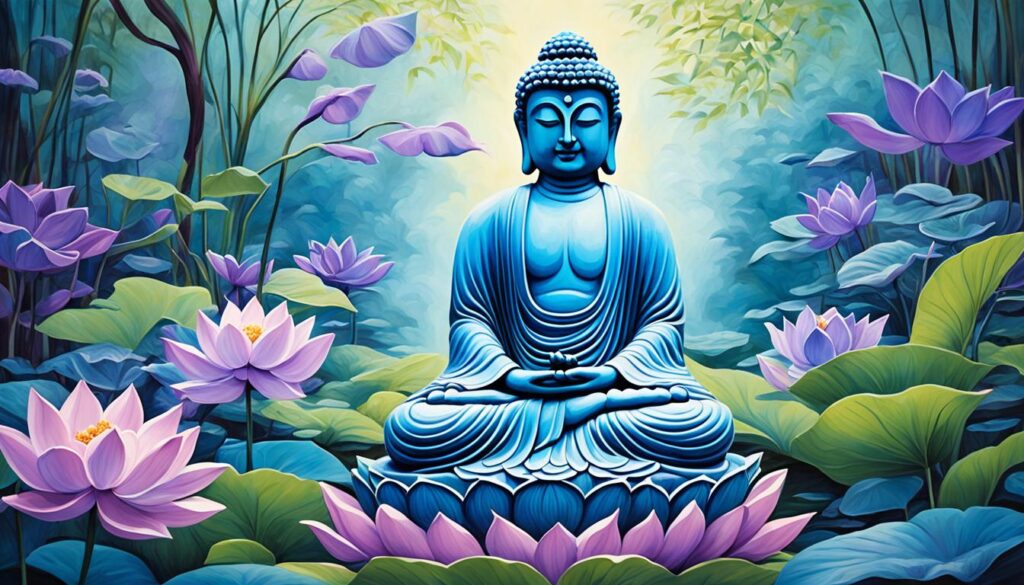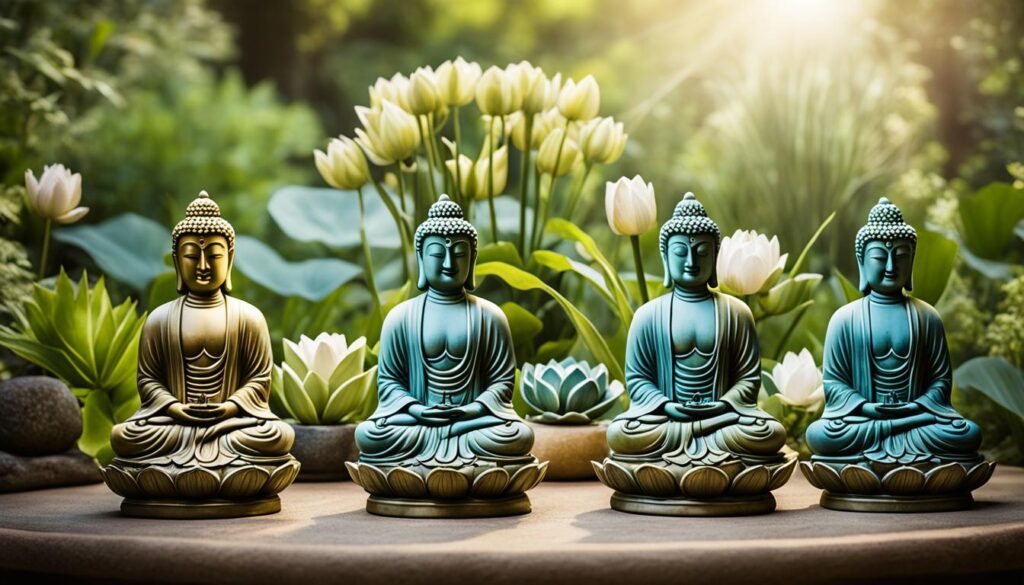Have you ever wondered how art can bring a sense of peace and serenity into your life? What if there was a way to connect with a rich heritage and gain insights for personal harmony through artistic expressions? Explore the world of Buddhist art and discover a path to tranquility and spiritual growth.
Key Takeaways:
- Traditional and contemporary Buddhist art offers a means to connect with a heritage of peace and serenity.
- Buddhist art embodies the teachings and principles of Buddhism, inspiring mindfulness and inner peace.
- Traditional Buddhist art includes sculptures, paintings, and thangka paintings that depict deities, scenes from scriptures, and historical figures.
- Contemporary Buddhist art explores themes of mindfulness, compassion, and interconnectedness through various mediums.
- Buddhist art is filled with sacred symbols that hold deep meaning and significance, such as the lotus flower, dharma wheel, and Buddha statues.
The Significance of Buddhist Art
Buddhist art holds deep significance as it embodies the essence of enlightenment, compassion, and inner peace. Through its powerful symbolism and intricate iconography, Buddhist art serves as a visual manifestation of the profound teachings and principles of Buddhism. It has the ability to inspire mindfulness and meditation, offering a transformative journey towards cultivating inner peace and spiritual growth.
By immersing yourself in the beauty and symbolism of Buddhist art, you are reminded of the core values of compassion and loving-kindness that are essential to the practice of Buddhism. The art serves as a powerful conduit for spiritual connection, enabling you to delve into the profound depths of your own being and connect with the universal essence of peace and harmony.
When you engage with Buddhist art, whether through admiring a sculpture, contemplating a painting, or meditating upon a symbol, you are invited to embark on a journey of self-discovery and self-transformation. The art acts as a mirror, reflecting the potential for growth and the path towards awakening.
This image showcases the intricate beauty of Buddhist art, capturing the essence of tranquility, mindfulness, and inner peace. It represents the sacredness and serenity that can be found within the realm of Buddhist art.
Mindfulness and Inner Peace
One of the profound qualities of Buddhist art is its ability to inspire mindfulness and cultivate inner peace. The inherent beauty and symbolism of the art form guide you into a state of present-moment awareness, allowing you to release distractions and connect with the depths of your being. As you gaze upon a Buddhist painting or sculpture, you are invited to observe each detail with intention and embrace the stillness within.
Through mindfulness, you can transcend the boundaries of space and time, entering a realm of interconnectedness where inner peace and spiritual growth flourish. The practice of mindfulness, rooted in Buddhist teachings, allows you to cultivate a deeper understanding of yourself and the world around you, ultimately leading to a greater sense of peace and harmony.
Buddhist Symbolism and Iconography
Buddhist art is rich with symbolism and iconography, each element imbued with profound meaning and significance. From the lotus flower symbolizing purity and enlightenment to the dharma wheel representing the path to liberation, each symbol serves as a visual reminder of the fundamental teachings of Buddhism.
The visual language of Buddhist art offers a gateway to spiritual understanding and growth. As you explore the intricate details and symbolism within a Buddhist painting or sculpture, you are invited to contemplate the deeper meanings and teachings behind each symbol. This contemplation fosters a greater understanding of the Buddhist path and encourages personal introspection, enabling you to uncover your own innate wisdom and potential for growth.
Cultivating Spiritual Growth
Buddhist art serves as a powerful catalyst for spiritual growth, offering a transformative journey towards self-discovery and self-realization. As you engage with the art form, you are encouraged to reflect upon the teachings of Buddhism and apply them to your own life. Through contemplation and introspection, you can uncover deeper truths, embrace compassion and kindness, and embark on a path of personal and spiritual evolution.
The art’s ability to evoke emotions, provoke introspection, and inspire spiritual connection makes it a valuable tool for those seeking personal growth and inner transformation. By allowing the art to guide you on your journey, you can cultivate mindfulness, embrace compassion, and nurture your own spiritual path towards greater serenity and enlightenment.
| Buddhist Art | Key Themes and Symbols |
|---|---|
| Sculptures | Depiction of deities, gurus, and historical figures |
| Paintings | Depiction of Buddhist scriptures, teachings, and stories |
| Thangka Paintings | Intricate and detailed paintings used for meditation and visualization |
Exploring Traditional Buddhist Art
Traditional Buddhist art encompasses a rich and diverse range of mediums, including sculptures, paintings, and thangka paintings. Each form of art carries its own unique significance in representing the teachings, history, and symbolism of Buddhism.
One of the most prominent forms of traditional Buddhist art is buddhist sculpture. These sculptures often portray deities, gurus, and historical figures, serving as objects of devotion and reverence. Crafted with meticulous detail, these sculptures reflect the spiritual essence and divine qualities associated with Buddhism.

Buddhist Paintings
Buddhist paintings encompass both murals and scroll paintings that depict scenes from Buddhist scriptures, teachings, and stories. A visual narration of the Buddha’s life and his teachings, these paintings serve as a means to inspire and educate practitioners, while also evoking a sense of spiritual connection.
Buddhist Thangka Paintings
A unique form of Tibetan Buddhist art, buddhist thangka paintings are renowned for their intricate details and vibrant colors. These portable and scrollable artworks often depict deities, mandalas, and spiritual concepts. Thangkas hold immense spiritual significance and are used for meditation, visualization, and as aids for spiritual practice.
Buddhist art has a rich history that spans centuries, reflecting the cultural influences and artistic styles of different regions. From the ancient sculptures of Gandhara to the breathtaking cave paintings of Dunhuang, the exploration of Buddhist art history unveils a tapestry of human creativity and devotion.
Exploring Contemporary Buddhist Art
Contemporary Buddhist art is a vibrant and evolving form of artistic expression that captures the essence of Buddhist philosophy in modern times. With a focus on mindfulness, compassion, and interconnectedness, contemporary Buddhist artists create profound works that resonate with the present generation.
These artists draw inspiration from Buddhist teachings and integrate them into their art, offering a unique perspective on the ancient wisdom while addressing the challenges of the modern world. Through various mediums such as painting, sculpture, installation art, and digital art, they convey profound messages of spirituality, personal growth, and social harmony.
Contemporary Buddhist art serves as a powerful tool for self-reflection and introspection. It invites viewers to contemplate the deeper aspects of life and encourages a sense of mindfulness in their everyday existence.
By exploring contemporary Buddhist art, you can witness how artists merge traditional techniques with modern aesthetics to create visually stunning and thought-provoking pieces.
Let’s take a closer look at some prominent Buddhist artists who have made significant contributions to the genre:
The Artistic Vision of Alok Hsu Kwang-han
Alok Hsu Kwang-han, a renowned contemporary Buddhist artist, creates captivating paintings that seamlessly blend Eastern and Western artistic traditions. His unique style focuses on capturing the essence of Zen Buddhism and the interplay between light and shadow.
Installation Art by Anish Kapoor
Anish Kapoor, a celebrated British-Indian artist, explores the concepts of spirituality and metaphysics through his monumental installation pieces. His sculptures, often characterized by their reflective surfaces, evoke a sense of transcendence and invite viewers to contemplate the nature of existence.
The Mindful Sculptures of Kiki Smith
Kiki Smith, an American artist, incorporates Buddhist principles into her sculptures, creating artworks that explore themes of nature, femininity, and spirituality. Her works often evoke a sense of mindfulness and invite viewers to reflect on their place within the natural world.
These artists, along with numerous others, contribute to the dynamic and ever-evolving world of contemporary Buddhist art, inspiring viewers to contemplate the deeper meanings of life and foster a sense of interconnectedness.
Through their artistic expression, these contemporary Buddhist artists provide valuable insights and reflections for the present time, offering a path towards personal growth, serenity, and enlightenment.

Sacred Symbols in Buddhist Art
Buddhist art is an exquisite tapestry of sacred symbols that hold profound meanings and spiritual significance. Each symbol represents a facet of Buddhist teachings and serves as a powerful reminder of the path to enlightenment. Let’s explore some of the key symbols found in Buddhist art:
The Lotus Flower

The lotus flower is a ubiquitous symbol in Buddhist art, representing purity and enlightenment. Just as the lotus emerges from muddy waters to bloom into a beautiful flower, it symbolizes the potential for spiritual growth and awakening. The lotus teaches us that even in the midst of challenges and suffering, we can transcend and find inner peace.
The Dharma Wheel
The dharma wheel, also known as the dharmachakra, is an iconic symbol representing the teachings of the Buddha and the path to liberation. It consists of eight spokes, symbolizing the Eightfold Path, which leads to the cessation of suffering and the attainment of enlightenment. The dharma wheel reminds us of the importance of ethical conduct, mindfulness, and wisdom in our spiritual journey.
Buddha Statues

Buddha statues are prevalent in Buddhist art and come in various forms, each with its own symbolic meaning. These statues often depict the Buddha in different mudras (hand gestures) and postures, each conveying specific qualities and teachings. Whether it’s the meditative posture of Dhyana Mudra or the teaching pose of Dharmachakra Mudra, Buddha statues inspire us to embody compassion, wisdom, and inner peace.
Mandalas
Mandalas are intricate geometric designs found in Buddhist art, symbolizing the universe and its cosmic harmony. These visually captivating patterns act as aids for meditation and visualization. By immersing ourselves in the detailed patterns of a mandala, we can achieve a state of focused awareness and connect with the divine presence within us.
The Bodhi Tree
The bodhi tree holds deep significance in Buddhist art as it is the sacred fig tree beneath which the Buddha attained enlightenment. It serves as a symbol of awakening, wisdom, and spiritual transformation. Depictions of the bodhi tree in Buddhist art remind us of the possibility of enlightenment and the potential for profound personal growth.
| Symbol | Meaning |
|---|---|
| Lotus Flower | Symbolizes purity, enlightenment, and spiritual growth |
| Dharma Wheel | Represents the teachings of the Buddha and the path to liberation |
| Buddha Statues | Depict various mudras and postures conveying specific qualities and teachings |
| Mandalas | Intricate geometric designs symbolizing the universe and aiding meditation |
| Bodhi Tree | Signifies awakening, wisdom, and the potential for spiritual transformation |
Conclusion
Embracing Buddhist art offers a transformative journey that allows you to connect deeply with the teachings and values of Buddhism. Through the beauty and symbolism of this art form, you can embark on a path of personal growth, serenity, and mindfulness.
Buddhist art, whether traditional or contemporary, serves as a powerful source of inspiration and reflection. It invites you to explore the depths of your inner self, encouraging self-awareness and fostering a spiritual connection.
By immersing yourself in the world of Buddhist art, you gain access to a rich heritage that transcends time and space. It provides a sanctuary where you can find solace and discover a profound sense of serenity, enabling you to navigate the challenges of life with grace and equanimity.
As you embark on this journey, let the sublime beauty of Buddhist art be your guide. Allow it to inspire and uplift your spirit, leading you towards personal growth, inner peace, and a deeper understanding of the world around you.
FAQ
What is Buddhist art?
Buddhist art encompasses a wide range of artistic expressions that represent the teachings, symbols, and history of Buddhism.
What is the significance of Buddhist art?
Buddhist art holds deep significance as it serves as a visual manifestation of Buddhist teachings and principles, inspiring mindfulness, meditation, and inner peace.
What forms does traditional Buddhist art take?
Traditional Buddhist art includes sculptures, paintings, and thangka paintings, with sculptures often depicting deities and historical figures, while paintings depict scenes from Buddhist scriptures and teachings.
What is the difference between traditional and contemporary Buddhist art?
Traditional Buddhist art follows ancient techniques and styles, while contemporary Buddhist art incorporates Buddhist philosophy into modern artistic expression, exploring themes of mindfulness and interconnectedness.
What are some sacred symbols in Buddhist art?
Some sacred symbols in Buddhist art include the lotus flower, which symbolizes purity and enlightenment, and the dharma wheel, which represents the teachings of the Buddha and the path to liberation.
How does Buddhist art promote personal growth and serenity?
By embracing Buddhist art, individuals can connect with the teachings and values of Buddhism, cultivating inner peace, mindfulness, and harmony in their lives.

